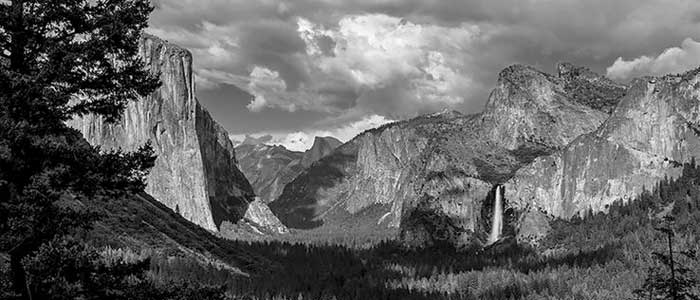‘The National Parks Project’ Exhibit Celebrates a Century of American
Reprinted from Wheretraveler.com
Houston-based photographer Mark Burns commemorates the National Park Service’s centennial anniversary on Aug. 25 with ‘The National Parks Project’ at the Houston Museum of Natural Science, on view through Sept. 21.
The complete series of photographs from all 59 national parks represents the culmination of Burns’ five-year endeavor (or, 150,000 miles in his FJ Cruiser throughout the continental U.S., plus trips to Alaska, Hawaii, Samoa and the U.S. Virgin Islands) of capturing the vast, majestic beauty of these natural American wonders, from Yellowstone and the Grand Canyon to Denali. Burns’ captivating, black-and-white photos, shot in a style reminiscent of Ansel Adams, pay homage to the early American artists who first captured the parks’ breathtaking beauty over a century ago.
We caught up with Burns in advance of the exhibition’s premiere in his hometown of Houston, who discussed his inspiration for the project and what he hopes visitors gain from seeing it.
What sparked the idea for ‘The National Parks Project’? Why did you choose to shoot the images in black-and-white?
In his PBS special ‘The National Parks: America’s Best Idea,’ Ken Burns mentions that it was arguably the works of early painters and photographers from the mid- to late-1800s and into the turn of the century—Thomas Moran, William Keith, Thomas Hill, Joseph Henry Sharp, Ansel Adams—that led a lot of those lands to be protected by the National Park Service, [because] lots of philanthropists looking at those paintings and photographs saw the need in protecting those parks. (Not far from the Houston Museum of Natural Science, the Pearl Fincher Museum of Fine Arts in Spring features an exhibition highlighting 28 images hand-selected by Burns alongside early oil paintings by Moran, Hill and Sharp—the artist who inspired his own project—on display through Sept. 3.)
That led me to my project. As a photographer, I wanted to photograph all the parks in black-and-white; to me, when you look at the photos I did [since] 2012, they’re done in the same style as what they would’ve looked like in the 1910’s-1930’s by a black-and-white photographer. I can do color, but I specialize in black-and-white so it was easy for me to want to do that; and because of the National Park Service’s 100th anniversary, it worked out.
After five years of traveling to all 59 parks, which are your favorites and why?
Yosemite, Yellowstone, Grand Teton, Grand Canyon, Olympic National Park in Washington. They’re special places in American West. Those protected in the first 50 years of the National Park Service are no-brainers; they’re amazing, and were some of the first parks to be protected because of their historical significance. Yellowstone was first national park in world … Yosemite is probably my favorite park in country, just because there are such beautiful places there. Yosemite Valley is relatively small; the waterfalls are unbelievable, and to be in that setting—down in the valley looking up at granite walls—it has this nurturing effect. But when you’re up on surface level looking at vast areas of land, there’s this different feeling of hugeness or largeness.
Texas has two national parks: Big Bend and Guadalupe Mountains. What makes them special or unique?
Guadalupe is about two hours straight east of El Paso right on New Mexico border. Big Bend is down below Marfa, in the Alpine, Texas bend of the river. It’s the best-known Texas park for sure, but Guadalupe National is pretty interesting place: In the lower level it’s desert-like terrain, but if you hike the trail up [to the summit of what is] the tallest mountain in Texas, I believe, you’ve got evergreen trees, lush, green grass—it’s totally different environment at top than you would ever expect.
Why is it important for the public to visit these protected parks?
National parks are very special places, and I’ll tell you this: Doing this project for five years changed me in a lot of ways. I’ve always had appreciation for the outdoors and the land, and [this assignment] further ingrained that in me. You start to form opinions about what [the parks] should be like, or wish things were more “natural.” [When I went] to Alaska for six weeks in 2014 and 2015 [to photograph] the eight parks there, the wilderness element blew my mind; there are just miles and miles of untouched nature—thousands of caribou and wildlife. I became very passionate about the environment. At Glacier Bay National Park, only three still tide water glaciers remain. That really made me think about climate change and man’s impact on it, whereas before I was one of those native Houstonians who grew up around oil industry in the 1970’s and ’80s, and just accepted our impact. While that may not affect our temperature that much, it doesn’t make it better.
What do you hope visitors gain from the exhibition?
I became very connected to the environment through this project; nature has a restorative effect on your mind and health. I hope people coming to the exhibit will want to experience some of the parks and their restorative properties. When the exhibit opened at George H. W. Bush Museum [last fall], several people said they were brought to tears looking at the photographs; it was one of the most wonderful things someone could ever tell me. It was so touching … I want them to feel something [from the photos], not just see or look at them. I hope the exhibit causes them to go out and see those places, and to think about the national parks and what they mean and why they’ve been protected.


Comments are closed.